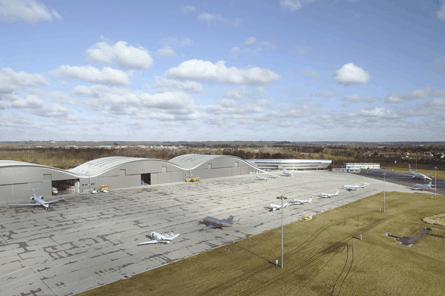Farnborough airport - one of Europe's most iconic business aviation hubs - could finally receive the green light to expand its movement ceiling after its Swiss owner TAG published its eagerly anticipated 10-year master plan for the UK's only dedicated business aviation airport.
TAG is now gearing up to apply for a 22,000 annual movement increase to keep pace with the expected demand for Farnborough between 2009 and 2019, while holding open the possibility of a further increase in the 2020-30 timeframe.
At the southern English airport's current level of operation - with a 28,000 movement ceiling - the infrastructure is significantly underused, says Brandon O'Reilly, chief executive of Swiss-owned TAG Farnborough. "While the physical capacity of the airport could accommodate up to approximately 100,000 air traffic movements, we will apply for a 50,000 ATM ceiling up to 2019 in light of current safety and environmental constraints," he adds. "The current runway, taxiways, aprons, passenger terminal, hangars and car parking facilities are entirely sufficient to meet this level of future growth."
 |
|---|
© TAG Aviation |
The masterplan will consider how the airport can meet future forecast demand for business aviation flights while minimising the effect on the local community and environment. Its publication follows two periods of consultation within the past year with local businesses and members of the public, some of whom have been outspoken opponents of the airport and resistant to any expansion at the site.
O'Reilly says that views expressed during the consultation have been incorporated into the document and have "helped to develop a set of commitments in respect of the airport's future. We have listened to all the concerns of the residents and have attempted to address them as best we can in this document," says O'Reilly. The consultation highlighted people concerns about the environment, in particular noise, which TAG has addressed. "TAG has already banned all aircraft not meeting [ICAO] Chapter III noise standards from the airport and within five years we will only permit Chapter 4 aircraft," says O'Reilly.
Other residents, he says are apprehensive that the airport's long-term strategy is to become a regional base for low-cost carriers or a cargo hub. "This is categorically not the case. TAG Farnborough will remain a business aviation airport," O'Reilly stresses.
"We want to make better use of existing infrastructure and see what balances need to be struck with the community in order to grow the number of flights at the airport [to 50,000 ATM by 2019] in a responsible way,"
The TAG Aviation subsidiary has seen business aircraft movements at Farnborough soar from 16,100 in 2003 - its first full year of operation at the site - to more than 25,500 last year. Although the operator is expecting an overall decline in movements this year due to the economic slowdown, movements at the airport are expected to rise significantly over the coming decade as the industry recovers.
"Commercial airports like Heathrow, Gatwick, Luton and Stansted are going to squeeze out business aircraft as demand from airlines increases, placing more demand on business airports in the region like Farnborough," says O'Reilly.
Last year TAG was granted approval from the UK government to increase movements on weekends from 2,500 to 5,000 - with no increase in the annual number of movements above 28,000. The move followed a protracted battle with the local government which declined the original request.
TAG has invested around £100 million ($150 million) upgrading Farnborough - home to the biennial Farnborough air show - since it took over the 99-year lease from the UK Ministry of Defence in 2001.
Eight years later and now in possession of the 235Ha (580 acre) site's freehold, TAG has almost completed the extensive modernisation programme. Farnborough now boasts a new terminal building and hangars - themselves icons of European business aviation - air traffic control tower, hotel, reprofiled and resurfaced runway and an instrument landing system. "We just need to complete the apron work at the western end of the airfield - scheduled for completion by 2010 - which will house new hangars," says O'Reilly.
Source: Flight Daily News























